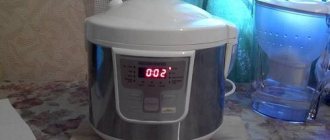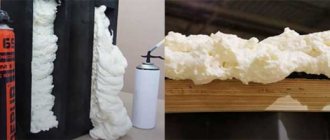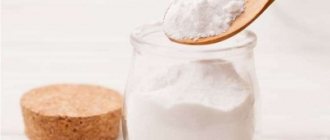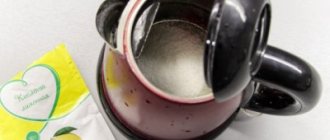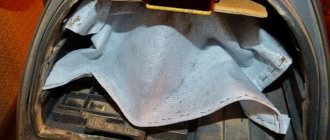We are accustomed to thinking that if the multicooker bowl is covered with a non-stick coating, then the food in it cannot burn. But that's not true. Moreover, not only can food stick to the bottom or sides, but the bowl itself can give off old unpleasant odors.
Proper preparation of the multicooker before washing
Before cleaning the multicooker:
- Unplug the device from the outlet.
- If you were cooking something, wait until the heating disc cools down.
- If the cover is removable, detach it from the “base”. If the cover is not removed, the heating component is protected from water and cleaning agents. It is enough to wrap the bowl in several layers of dense polyethylene.
- Next, remove other removable parts - bowls, valves and moisture collectors.
Prepare equipment cleaning products:
- sponges;
- soft cloth for wet cleaning;
- microfiber cloth for dry cleaning;
- dishwashing detergents;
- improvised home remedies - household. soap, vinegar, lemon juice, baking soda;
- rubber gloves to protect hands.
If you just bought an item, be sure to wash it thoroughly - the equipment must be cleaned of all factory contaminants and freed from the smell of plastic.
Before cleaning your multicooker, consider these tips:
- To avoid damaging the equipment, do not place a wet bowl in the device - wait until the container is completely dry.
- The most delicate cleaning of the device is with microfiber cloths.
- Do not wash the sealing rubber with hot water - this will destroy its tightness.
- If the device emits a persistent smell of rancid food, add 2 tbsp to the cleaning solution. spoons of lemon juice.
- If food continues to burn even after washing the bowl, then the non-stick layer is damaged and the container needs to be replaced.
My bottom
During the cooking process, food particles or drops of fat often get into the space between the bowl and the bottom of the multicooker.
Therefore, after washing the bowl, do not rush to put it back in place: carefully inspect the bottom of the device and, if necessary, clean it of crumbs and grease stains with a pre-moistened soft cloth.
In case of significant contamination, soak a sponge in water, then in baking soda and very carefully clean the bottom of the household appliance.
ADVICE! After removing the fat, rinse the bottom and walls with clean water and wipe them dry with a towel.
How to clean the multicooker bowl?
The difficulty of washing multicookers is that the device cannot be cleaned as a whole - all removable components are washed separately. We'll start with the bowl - depending on what material it's made of, cleaning varies.
Ceramic bowl
Remember that this is a fairly fragile item that needs special care:
- Protect the container from hitting the walls of the sink or dishwasher basket. It is best to wash ceramics by hand.
- Avoid abrasive scourers, caustic agents, and acids.
- Do not use soda (both baking soda and baking soda) and various cleaning powders for washing.
- If there are often burnt food residues, do not remove them using iron sponges, scrapers and brushes. This will damage the non-stick coating.
- The best substance for washing is liquid, helium, with abundant foam formation. In principle, any dishwashing liquid fits this description. There are also special gels specifically for ceramics.
- Remember that non-stick shells are sensitive to sudden changes in temperature - wash the bowl only when it has completely cooled.
Teflon bowl
Teflon is a less capricious material when compared to ceramics, but it also has its own care rules:
- Do not use powder mixtures, abrasive scourers or metal scrapers. They stop unnoticeable scratches on the surface, which over time deepen to large cracks in the body.
- Give preference to delicate gel cleaners that do not contain acids.
Most Teflon containers clean well in the dishwasher. But still, before cleaning, it is better to make sure by reading the instructions for the device.
If you need to clean the multicooker from carbon deposits:
- Fill the bowl with water and leave to soak for 1 hour.
- Using a wooden spatula, carefully remove the carbon deposits.
- Does not help? Add 1 tbsp. spoon of soda, pour 500 ml of water. You can dilute the juice of ½ lemon in 1 glass of water.
- Place the container back into the multicooker.
- Turn on the device, switch to the “Baking” mode, but do not close the lid.
- When the liquid boils, wait another 10 minutes and turn off the equipment.
- After 30 minutes, try again to remove the carbon deposits with spatulas.
- Wash with dish gel, wipe dry outside and inside.
Bowl care
After purchasing, first remove the bowl and rinse with warm water and a regular neutral detergent. You need to wash with a soft cloth.
Bowls are washed with liquid and gel-like products, do not use alkalis, acids or abrasives. Unlike Teflon bowls, ceramic bowls are not dishwasher safe.
What to do if food is burnt?
If, for example, pilaf or porridge is burnt, fill the container with water until it burns and leave for 30-40 minutes. The carbon deposits will soften and can be removed with a wooden spatula or sponge. If it doesn’t help, then do the following: pour 2 cups of water into a container and a teaspoon of soda. Turn on the baking mode and let the solution simmer for 10 minutes with the lid open. Half an hour after this, try again to remove traces of burnt food with a spatula.
Tip: If you notice that the food in the bowl is constantly burning, you need to replace it with a new container. Most likely, due to improper care, small and large scratches or cracks have formed on the inner surface.
How to properly clean the multicooker body?
How to clean the multicooker body? No matter what type of multicooker you have, it cannot be washed under running water from the tap.
Cleaning outside
When you actively use the device, you will notice that its outer side also becomes dirty and covered with traces of grease.
The easiest way to clean a multicooker from fat is to use the following recommendations:
- Use gels and sprays to clean household appliances.
- If the surface is plastic, do not use abrasive powders.
- The metal body can be thoroughly washed off old dirt with regular baking soda.
- To make your multicooker literally shine, apply a little glass and mirror cleaner to a piece of rag. Rub it onto external surfaces that do not come into contact with food.
How to clean the inside of the multicooker body?
For convenience, housewives combine cleaning of the housing and the heater.
Here's how to clean the inside of your multicooker:
- Disconnect equipment from the network.
- Remove removable components.
- Make foamy water by diluting a little dish gel in water.
- Dip a cloth in the solution and wring it out well.
- Gently wash all internal parts with a damp cloth - bottom, sides, tank.
- Use a soft dry cloth to wipe all surfaces dry.
- Leave the device open for a while to allow the water to evaporate.
What can I wash it with?
Regular dishwashing liquid is suitable for cleaning the multicooker. It will help remove grease and other impurities. Some parts (body, heating element, outer cover) can simply be wiped with a damp cloth. If scale forms in the condensate receiver, descaling agents can be used. If you wash individual parts in the dishwasher, you can use regular tablets or capsules.
The exception is bowls with non-stick coating. Check the capsule or tablet instructions to ensure that the coating will not be damaged when washed.
| Detail | What can I wash it with? | How to clean heavy stains? |
| Housing outside | Wipe with a damp cloth | Soap solution |
| Bowl | Dishwashing liquid | Non-abrasive cleaning gels or creams for dishes |
| A heating element | Wipe with a damp cloth | A small amount of soap solution |
| Inner cover | Dishwashing liquid | Non-abrasive cleaner |
| Steam valve | Rinse with running water | Soap solution or descaling agent |
| Condensate receiver | Rinse with running water, wipe dry | Decalcifying agent |
| Measuring spoons, steamers and other accessories | Dishwashing liquid | Non-abrasive cleaner |
Some products cannot be used to clean a multicooker:
- any abrasive powders, gels, pastes or creams;
- household chemicals based on alkalis and acids;
- cleaning products that should not come into contact with dishes (due to their aggressive or potentially dangerous composition);
- solvents;
- grease removers with aggressive composition;
- soda, salt, any other abrasive powders;
- sponges, brushes, rags with an abrasive surface.
To understand whether the multicooker can be washed with the selected product, make sure that it meets the following requirements:
- does not contain abrasive particles, does not scratch or damage the contaminated surface;
- does not contain dangerous, toxic, caustic chemicals;
- Easily washed off surfaces, leaves no traces;
- does not leave any odor on washed or cleaned surfaces.
Before using any cleaner or detergent to clean your multicooker, read the instructions that come with it and make sure it is safe to use.
Proper cleaning of the multicooker lid
Let's figure out how to wash the multicooker lid. Depending on whether it is removable or not, there are two instructions.
Removable cover
The simplest procedure: first you clean with a washcloth or napkin with dish gel, and then rinse off the detergent under running water. If the manufacturer does not prohibit it, a heavily soiled lid can be soaked in soapy water before cleaning.
Fixed cover
To properly clean such a cover, you first need to protect the heater disk from moisture. Since it is located at the bottom, take thick polyethylene or cling film and line the bottom with it, making allowances for the walls.
Here's how to clean a multicooker at home:
- Tilt the device over the table so that the lid lowers to a horizontal position.
- Periodically dip the washcloth in the foamy dishwashing gel solution.
- Pay special attention to the most contaminated places - the sealing rubber and the hole for the steam valve.
If the non-removable lid is very dirty and cannot be washed, proceed as follows:
- Reinstall the bowl (if it was removed).
- Add 1 tbsp to the container. a spoonful of lemon extract (can be replaced with 2 pieces of fresh citrus) and 1 glass of water.
- Switch the device to “Steam” mode and leave for 20-30 minutes.
- Allow the equipment to cool, remove the bowl, and unplug it from the outlet.
- To clean the multicooker from grease, repeat cleaning with a sponge and soapy water - the grease deposit has already softened, it will be easier to remove.
A heating element
The heating element of a kitchen appliance must always be kept perfectly clean. If grease, crumbs or other contaminants get on its surface, do the following:
- Disconnect the multicooker from the power supply and let it cool completely;
- remove the device bowl;
- Use a soft foam sponge to remove large debris from the heating part.
REFERENCE! If there is plaque left on the element, lightly moisten the sponge in water, dip it in soda and very carefully wipe the surface of the part, then remove the remaining product with a damp cloth, dry the treated surface with a towel.
Cleaning the bottom and heating disc of the multicooker
The heating device must be protected from liquids and food particles.
If food still gets on the disc, here's how to clean the inside of the multicooker:
- Dilute 1 tbsp. a spoonful of baking soda in 1 glass of water until the powder is completely dissolved. You can make a solution by stirring a small amount of dish gel in water until a rich foam forms.
- Take a soft washcloth, dip it in the prepared solution, and squeeze thoroughly.
- Clean the heating component from dirt with a sponge.
- After cleaning, wipe the element dry with a soft cloth.
- It is recommended to keep the device open for some time to allow all the liquid to evaporate.
If there are only dried crumbs inside the device, you can carefully sweep them out with a damp cloth and then wipe dry with an absorbent cloth.
Recommendations for care and use
Cleaning the multicooker inside and out is not that difficult, even if there is burnt fat. But when using the device, it is recommended in principle to prevent the formation of old deposits. During operation of the unit it is necessary:
- Wash the bowl and lid of the device after each cooking.
- When inactive, keep the multicooker open to prevent humidity from rising inside and unpleasant odors from accumulating.
- Remove food from the bowl immediately after cooking and transfer it to another container for storage.
At least once a month, it is recommended to carry out full maintenance of the unit - wash the steam valve and the bottom of the device, wipe the heating element with a dry cloth.
The multicooker should be kept away from direct sunlight and heating appliances.
How to clean the steam valve in a multicooker?
Do not forget to monitor the condition of this element: if it is clogged with food debris, it will not be able to properly pass moisture through itself, which means that the cooking technology will be disrupted.
When you run your slow cooker constantly, make it a habit to clean the valve every week. If during cooking the dish has risen to the lid, it is best to clean the part immediately after using the unit.
Cleaning is the simplest: rinse the element under running water. If there is old dirt on the valve, soak it in foamy liquid, and then rub it well to remove grease deposits with the hard side of a dishwasher.
Moisture collector
Absolutely all models of kitchen appliances are equipped with a moisture collector - a special container designed to collect condensation that forms on the lid during cooking.
After each use of the multicooker, the moisture collector should be emptied of accumulated moisture and washed with running water and detergent.
If liquid is not removed from the reservoir in time, mold may develop in the device . Be sure to dry the moisture collector before installing it in place.
Folk remedies for cleaning multicookers
To make your multicooker look like new, you don’t need to buy expensive imported substances. You can get by with proven and effective folk remedies to get rid of the smell in the multicooker.
Soda
First, make sure that the surface can be cleaned with powder and abrasive products.
To thoroughly clean the body and the outside of the lid, you need:
- Mix 2 tbsp. spoons of baking soda with 50 ml of water - you will get a homogeneous “puree”.
- Apply a little product to a sponge and wipe the dirty areas with it.
- Leave the soda slurry on the surface for a while.
- Remove the product containing wet grease with a damp cloth.
- Wipe dry with paper or cloth napkins.
Vinegar
Ordinary table vinegar not only removes unpleasant odors, but also perfectly eats away fat.
The simplest “recipe” for cleaning a multicooker:
- For 1 liter of water - 1 tbsp. spoon of vinegar. To prevent it from emitting an unpleasant odor, take not a table odor, but an apple one.
- Soak a soft cloth in the solution and wring it out.
- Wipe the body, lid, and tanks inside and out with a cloth.
- Wipe dry with a soft microfiber.
If the contamination is persistent, try setting up a steam vinegar bath - a great way to clean the inside of the multicooker:
- Take a heat-resistant container, pour 1 glass of water, 1 tbsp. a spoonful of food vinegar.
- Place this bowl at the bottom of the steamer bowl and close the lid of the device.
- Activate “Steam cooking” for half an hour.
- Wait until the device cools down.
- All you have to do is wipe the contaminated surfaces with a sponge to remove softened fatty deposits.
Lemon acid
A remedy for grease and unpleasant odor.
See how to remove odor from a multicooker:
- Cut the lemon into several small pieces.
- Pour into the multicooker bowl, add 1 liter of water.
- Close the lid and activate the steam mode for half an hour.
- Wait until the device cools down.
- Wipe the bowl and interior surfaces of the multicooker with a microfiber cloth.
How to remove unpleasant odors
Even a clean bowl can give off old odors:
- products (fish, garlic, seasonings, etc.);
- sour, rotten food;
- burning.
To prevent the inside of the multicooker from becoming saturated with persistent aromas after cooking, follow the following rules for caring for the household appliance:
- Do not leave the prepared food in the bowl, cool it, transfer it to another saucepan and put it in the refrigerator.
- If a smell appears, you can boil a solution of salt or soda in a bowl (1 teaspoon per liter of water).
- You can wipe a clean vessel with apple cider vinegar, and do the same with the lid.
- A good way is to leave ground coffee powder in a bowl overnight.
The smell of rotten meat, fish or garlic aromas must be combated with the help of spices. Pour water, add ground allspice, celery roots, lemon slices, boil for 20 minutes. After cooling, the bowl should be rinsed with clean water and left to dry in the open air.
Advice! When storing, remove the bowl from the multicooker or open the lid slightly for ventilation.
How to prevent pollution: tips and tricks
To clean your multicooker as little as possible, you just need to follow simple rules:
- Remove dirt as soon as you notice it.
- Make sure that crumbs do not fall under the bowl onto the heating disk.
- Before cooking, check that there are no crumbs or wet spots at the bottom of the bowl.
- Place the multicooker only on a clean surface.
- Wash the bowl and wipe the body of the device after each cooking.
- Make sure that the steam valve is not blocked, otherwise a rotten smell will appear.
How to care?
- Do not leave the cooked dish in the bowl for a long time - immediately after finishing cooking, transfer the food to another container.
- Rinse the device bowl after each use of the device.
- Dry equipment only with the lid open.
- Do not install the household appliance near heating devices: the multicooker should be located at a distance of 15-20 cm from the oven or hob. It is also prohibited to operate an electrical appliance that is located next to a sink, sink or other water reservoir.
- Before loading food into the device, make sure that there are no foreign objects in the bowl and that the container is level.
Was this article helpful to you?
Not really
Caring for a multicooker requires minimal investment of money, time and effort - just 15-20 minutes will be enough for you to completely put your device in order after cooking.
The cleanliness of a household appliance is the key to a long service life of the equipment and the quality of the food prepared in it.
Chemicals
The assortment of household chemical manufacturers offers a whole range of products designed to care for kitchen appliances, including multicookers.
Here are just a few of them:
- Mr. Chister;
- Zumman;
- Reinex;
- Top House;
- Sanita;
- Sif;
- Amway;
- Comet.
These preparations are available in creamy or gel forms, act gently on the surface, and easily cope with grease and dirt.
Before use, do not forget to read the instructions - the composition must be compatible with the material of the bowl and the coating of the multicooker.
Other details
Water procedures for the lid and body. Removable lids are carefully removed and washed with dish gel and a microfiber cloth. After wiping it dry, the lid returns to its place.
Stationary lids are much more difficult to clean. The most inconvenient part will be the rubberized part, which will require more time and effort to keep clean.
- Initially, the lid is cleaned using steam. A glass of water is poured into the bowl and lemon juice is added. The device must be set to a fifteen-minute steaming mode.
- Next, the multicooker body is wrapped in thick cellophane, leaving only the lid outside. The unit is moved slightly forward to ensure that the surface of the lid can be thoroughly washed away from grease and condensation. It is important to prevent moisture from getting on the opening assembly and inside the plastic bag.
- The lid is cleaned with a soft sponge using dish gel. The foam is washed off with water. The silicone should be processed very carefully, without leaving dirt in its grooves.
- Initially, the multicooker is disconnected from electricity. This is still an electrical appliance that cannot be completely immersed in water.
- The body is wiped with a damp cloth, drops of water or splashes of grease are removed from it. Then the surface is wiped dry. After removing the valve from the cover, inner disk and bowl, the body is wiped inside.
- When water gets inside the housing, it is destroyed by turning the device upside down with the electronic unit. Dry all parts with a clean, dry towel. It doesn't hurt to use a hairdryer to dry it. It is not recommended to turn on the device for 24 hours before final drying.
- The heating element is wiped with a damp cloth. There are cases of contamination of the heating element with drops of fat or “escaped” food. For such cases, it would be appropriate to use baking soda to clean it.
Cleaning the moisture trap and steam valve. During cooking, condensation forms on the lid. It is collected in a special container - a moisture collector. After each cooking cycle, this container is removed to empty the accumulated water and washed under running water.
The purpose of the steam valve is to release excess steam. It does not require frequent washing. But sometimes it should still be disassembled and washed with dishwashing gel, which perfectly degreases. It is important that the holes are not blocked for good steam passage.
As a rule, the valve consists of a retainer and a rubber seal. It is easy to get, but it is forbidden to stretch it to avoid deformation. The inner disk removed from the cover is processed in the same way.
What to do with a non-removable lid?
To clean a model with a stationary lid, you will have to suffer a little. You can do this in one of the following ways:
With steam bath. Pour a glass of water into the bottom of the device and squeeze a little fresh lemon juice into the liquid. Close the lid and start the unit for 15 minutes using the “Steam” mode. The cover can now be cleaned. To do this, it is enough to use dishwashing gel, but in order not to spoil the device, its body will have to be wrapped in cellophane and turned so that only the lid is cleaned. Be sure to wash off the foam from the surface and dry the treated areas as much as possible with a towel.
Using laundry soap. For a more aggressive approach, we need to soap a damp cloth with laundry soap and carefully treat the lid, trying not to touch the other parts. After we have managed to get rid of the grease, take a clean rag, moisten it and wash off the foam. Although this approach gives an optimal result, it has its drawback - it will not be so easy to get rid of the smell of laundry soap.
In cases of extreme contamination, the above approaches can be combined. Even the oldest dirt cannot resist this.
If cleaning the lid has been neglected for a long time, then most likely grease will accumulate behind the rubber inserts. To remove it, you can use toothpicks or cotton swabs. You just need to act carefully so that the sides also fit tightly to the surface after processing.
Do I need to wash the multicooker after purchase?
You shouldn’t immediately after purchasing, put food into the bowl and start cooking. It is likely that during production and sale the device was exposed to various influences, so before use, it is better to wash all parts that will touch the products. Wipe the outer and inner parts of the body with a damp cloth, and the bowl and lid with a soapy water solution.
Before first use, pour a glass of water into the bowl and turn on the “steam” mode for 10 minutes. The procedure will help get rid of residual substances applied during final processing of the product at the factory.
Washing in certain cases
Often, for various reasons, during the operation of the device, situations arise when liquid or semi-liquid food spills out through the lid of the multicooker. In these cases, it is necessary to know in advance how to properly clean the device and how to prevent unforeseen circumstances. This usually happens when users ignore the recommendations specified in the instructions for the device, as well as:
- loading too much food into the bowl;
- the temperature is set incorrectly;
- they choose the wrong cooking process, for example, boiling instead of stewing;
- leave the device cover open.
Also, sometimes the temperature regulator in multicookers breaks down, which can also cause soup to run away or burnt porridge. In order to wipe the heating element, you can use a special brush with stiff bristles, then wipe with a sponge and a dry cloth. Do not place the multicooker under running water or rinse the device after washing to avoid damaging important parts.
All these recommendations are relevant for devices of any brand, including Redmond. After all the parts of the device have been thoroughly washed and wiped, they should be put back together, the bowl should be placed back into the multicooker, the additional accessories should be washed and put back in place. Proper and complete care of this kitchen appliance will help to extend its service life for a long time and prevent numerous breakdowns.
Between us girls
The cartoon is washed, the kitchen is in perfect order... but what about the hostess? Admit it, have you gained a couple of extra pounds over the winter? Or all eight?
- Don’t have the time, money or energy to go to the gym?
- You understand that this summer you will no longer be able to afford the outfits that helped you catch the admiring glances of men...
- And sometimes truly passionate...
- You begin to forget those moments when your beloved man picked you up, circled you in his arms and whispered such warm and pleasant words in your ear...
- And every time you approach the mirror again, it seems to you that the old days will never return...
No need to be upset, start changing right now! Follow the link and find out the rating of the most effective weight loss products according to the “Test Purchase” version.
How to clean a steamer?
To clean the multicooker lid without any effort, remember a few simple but very practical tips. They will come in handy more than once when cleaning, but will not harm the device:
Expert opinion
Ksenia Diyanova, expert on beauty, purity, harmony
Ask me any questions, I will be happy to answer!
Spend only 5 minutes on washing, and then you will not need to wash the lid with household chemicals, and the multicooker itself will serve you for many years. The body of the unit cannot be cleaned even with the most gentle solvent, but only with warm water with the addition of dishwashing gel. There is an individual approach to every detail of the multicooker! Ask me all your questions, I will be happy to answer!
Selection of detergents and necessary materials
When choosing detergents, ignore any powders, pastes or gels that contain abrasive particles. Some parts are very fragile and such products will quickly damage the device. Therefore, for safety reasons, it is better not to use aggressive methods. You should only use delicate products and soft sponges.
For gentle care, use the German hypoallergenic detergent for multicookers “Top House”, or any surfactants such as “Pril”, “AOS” and others. People recommend soap solution, liquid soap and soda for individual parts.
Useful tips
At home, unpleasant odors are neutralized in several ways:
- Use of citric acid. Dissolve half a dessert spoon of citric acid in 250 ml of water and turn on the steam cooking mode for 10-15 minutes;
- Ventilation. First, you need to remove the removable elements of the multicooker and place them in a room where there is especially good air circulation or outside, on a balcony. After some time, the odors will dissipate;
- Vinegar. Strong odors will go away if you wipe the walls of the bowl with a soft cloth moistened with a 9% vinegar solution. The vinegar smell will dissipate within five hours.
- Coffee beans are also helpful in eliminating pungent odors. Simply put the grains in a bowl for 24 hours.
- A mixture of salt and soda (1:1) is poured onto a cloth (rolled up in the shape of a bag) and placed in a closed device for 12 hours. These components will perfectly absorb foreign odors.
- Activated carbon is also used for this purpose. Application is similar to the previous one. The number of tablets must be at least 10 pieces. If the smells do not go away, then increase the dose.
If the device is used incorrectly, food may begin to leak out of the multicooker.
Causes:
- The cooking mode for this dish has been set incorrectly;
- The lid is not tightly closed;
- More products have been placed than necessary;
- Malfunction of the temperature sensor or the control unit as a whole.
Solutions:
- Disconnect the device from the power supply, disassemble and wipe the heating element with a soft brush;
- Gently wipe the bottom of the bowl with a soft material;
- It is allowed to assemble all the components into the multicooker set only after they have completely dried.
- If you find burnt food, you must thoroughly wash the multicooker.
- To renew the non-stick coating, grease the walls of the bowl with sunflower oil (once every 3 weeks).
The service life of a multicooker depends entirely on caring for it and proper use . Now you know how to clean a multicooker from grease inside and out. Compliance with all of the above recommendations will maximize the service life of the device.
You can see how to clean a multicooker from grease in the following video.


